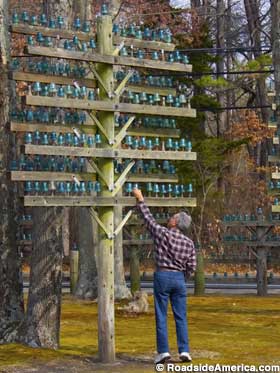For years, if one were driving near Atlantic City, New Jersey, perhaps taking a shortcut between the Atlantic City Expressway exit 12 and the Garden State Parkway exit 41 due to summertime congestion, one might pass something on the side of the road that might cause a momentary feeling of disbelief where one might question what they just saw. Located at the edge of the famous New Jersey Pine Barrens in Galloway Township, the slightly less famous Insulator Ranch was chronicled in all the typical quirky attraction websites like Weird NJ and Roadside America as it sat there provoking thousands of double takes over the years. Insulator Ranch was exactly that, a ranch house with a circumferential fence-line constructed entirely of railroad pole-line poles fully stocked with green glass insulators.
I first stumbled upon the site in the summer of 1998 and likely passed it once or twice in the years that followed. In the age of Google Maps I would check in periodically, confirming that it was both still there and that my mind had not been playing tricks on me in ages past. Then, just recently, a check of the updated Street View showed that while the home and property were still there, all the magic of the green glass insulators had gone. According to the reports, the creator of the insulator art piece, a one Stanley E. Hammell, had passed away at age 89 in 2012 and was followed by his wife in 2018. I am sure one could probably dig deep enough to find out what the family did with the over 10,000 green glass insulators, but surprisingly, their fate has eluded the reach of Google.
Mr. Hammell said that he began his collection in 1985 and continued through to the early 1990's. He talks about train shows and walking various rail lines, all things I am sure he did, but none of the articles provide insight into where I am confident he obtained the bulk of his collection because its the same place that my family came away with bushel baskets of our own. The former Camden and Atlantic, aka PRSL Main Line from Lindenwold to Atlantic City.
Having once hosted the fastest scheduled trains in the world, by the 1970's the PRSL Main Line to Atlantic City was a shadow of its former self, seeing a paltry peak direction service of ~3 daily round trips. By the late 1960's, the a double tracked, cab signaled main line constructed to PRR standards had been reduced to a single track with manual block operation south of Winslow Jct. In 1983 NJ DoT threw in the towel when Conrail stopped providing commuter rail contract services and all remaining signal infrastructure on the line was switched off and abandoned in place. This created a bit of a collector's gold rush with my then future shop teacher making away with an entire PRR position light mast signal and a single fallen pole providing my own family with decades' worth of giftable insulator paperweights.
In 1985 Mr. Hammell would find this semi-abandoned rail line with 40 odd miles of green glass insulated pole line just a few miles from his front door. I am not sure what his early collecting methods would have involved, but about 5 years later the route would see a complete reconstruction with modern signaling that had no need for lineside poles. As you can see in the photo above not a single pole line pole remains. This means they were cut down in mass by a scrapper looking to recover the copper telegraph wire. This is a fairly common practice and I am convinced that a certain retiree happened to find himself at the right place at the right time to capture large numbers of the otherwise "worthless" insulators that he would go on to assemble into a monumental yet underappreciated work of roadside art.
Insulator Ranch was one of those local institutions that seemed destined to last forever until suddenly it was gone. I never got any of my own high quality photos of the installation or spoke to Mr. Hammell or even had whichever car I was in slow down or stop. I am assuming that the collection found some sort of home as a lot of 10k+ green glass insulators would be certainly worth money, but it still goes to show that institutions are run by people and people get old and die. The next time you see some unique railfan house, don't be so sure that another member of the community will step up to purchase it when the time comes.


No comments:
Post a Comment